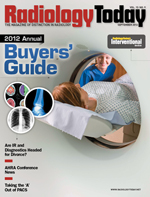 September 2012
September 2012
Four ICD-10-CM Documentation Tips
By Jean Stoner, CPC
Radiology Today
Vol. 13 No. 8 P. 14
As you’ve likely been briefed on many times, the new code set for assigning diagnosis codes, called ICD-10-CM, is currently proposed to go into effect October 1, 2014. Among other differences, ICD-10 requires much more specific documentation than the current ICD-9-CM version. Use these four pearls of wisdom as a starting point to help you prepare for the increased specificity that will be required on all radiology reports when the coding change occurs.
1. Laterality
Just about every ICD-10-CM code that can have a right and left variation has one, so remember to add this information to anything that has a right and left option. Based on a recent review of thousands of radiology documents, many radiologists seem to already be providing this documentation in many cases, but there are some symptoms and diagnoses that are still routinely missing this information. Note that for the following diagnoses, certain information must be documented:
• Breast, lung, and ovarian cancers must specify right or left breast, lung, or ovary, respectively.
• Tinnitus and otitis media must specify right or left ear.
• Meniscal tear must specify right or left knee.
To prevent confusion, it’s best to document this information as part of the diagnosis statement (eg, bucket-handle tear right medial meniscus) in the impression section rather than leaving it ambiguous and requiring the coder or computer-assisted coding program to detect the laterality from the exam title or clinical indication.
2. Encounter Type
All accident and injury ICD-10-CM codes must include a seventh digit to indicate whether an encounter is initial, subsequent, or sequela in nature.
Initial: This designation relates to when a service was rendered during the patient’s initial encounter for diagnosis and “active treatment” of the condition. If an exam is performed during the patient’s initial admission or emergency department (ED) visit after the injury, document “initial encounter.” The following are examples of this encounter type:
• an ankle X-ray for an ED patient after a twisting injury that day (nearly all exams for ED patients will be initial encounter);
• a brain MRI for a patient admitted from the ED after concussion;
• an intraoperative X-ray for a fracture to help with hardware placement for fixation; and
• a CT of the chest, abdomen, and pelvis for injuries from a motor vehicle accident.
Subsequent: This relates to a service that was rendered after the initial diagnosis and treatment were completed, “receiving routine care for the condition during the healing or recovery phase” (eg, follow-up fracture to check healing). If the exam is performed after the initial treatment is completed, document “subsequent encounter.” Examples of these encounters are as follows:
• a follow-up tibia-fibula X-ray four weeks after casting to check the healing progress; and
• a follow-up wrist X-ray at four weeks and six weeks to check on a fracture malunion.
Sequela: Lastly, this documentation is used for complications or conditions that arise as a direct result of a condition, such as scar formation after a burn (the scars are a sequelae of the burn). Examples are as follows:
• a knee MRI for pain due to an old meniscal tear;
• a shoulder X-ray for pain due to an old rotator cuff tear; and
• a hip X-ray for gait disturbance due to an old hip fracture.
3. Fracture Healing Status
ICD-10-CM fracture codes require a seventh-digit character for follow-up (subsequent) exams to indicate the status of healing. One of the following healing categories should be documented for all follow-up fracture exams: routine healing, delayed healing, nonunion, or malunion.
4. Anatomy
Some ICD-10-CM codes have very specific anatomy descriptions, more so than ICD-9-CM. Be as specific as possible when describing anatomy in your documentation. Here are some examples of the degree of anatomy specificity that will be required in ICD-10-CM:
• For a cerebral infarction, which artery was affected? Is it the precerebral, cerebral, middle cerebral, anterior cerebral, posterior cerebral, or cerebellar artery?
• For lung cancer, be sure to designate between the main bronchus vs. the upper, middle, or lower lobe. Are there overlapping sites?
• For an ankle fracture, be sure to document whether it’s the medial or lateral malleolus. Is the fracture bimalleolar or trimalleolar? If none of these are specified, you will have to assign the generic “Other fracture of lower leg” ICD-10-CM code.
• For an ankle sprain, be sure to specify ligament type, whether it’s the calcaneofibular, deltoid, or tibiofibular ligament.
— Jean Stoner, CPC, is a clinical development analyst at 3M/CodeRyte.

